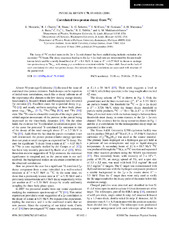| dc.creator | Mercurio, K. | |
| dc.creator | Charity, R. J. | |
| dc.creator | Shane, R. | |
| dc.creator | Sobotka, L. G. | |
| dc.creator | Elson, J. M. | |
| dc.creator | Famiano, M. | |
| dc.creator | Wuosmaa, A. H. | |
| dc.creator | Banu, A. | |
| dc.creator | Fu, C. | |
| dc.creator | Trache, L. | |
| dc.creator | Tribble, Robert E. | |
| dc.creator | Mukhamedzhanov, A. M. | |
| dc.date.accessioned | 2011-09-13T21:27:26Z | |
| dc.date.available | 2011-09-13T21:27:26Z | |
| dc.date.issued | 2008 | |
| dc.identifier.citation | K. Mercurio, R. J. Charity, R. Shane, L. G. Sobotka, J. M. Elson, M. Famiano, A. H. Wuosmaa, A. Banu, C. Fu, L. Trache, Robert E. Tribble and A. M. Mukhamedzhanov. Phys.Rev.C 78 031602 2008. "Copyright (2008) by the American Physical Society." | en |
| dc.identifier.uri | http://dx.doi.org/10.1103/PhysRevC.78.031602 | |
| dc.identifier.uri | https://hdl.handle.net/1969.1/127066 | |
| dc.description | Journals published by the American Physical Society can be found at http://publish.aps.org/ | en |
| dc.description.abstract | The decay of (10)C excited states to the 2p + 2 alpha exit channel has been studied using inelastic excitation of a secondary (10)C beam. The decay sequences leading to the 2p + 2 alpha final state are determined for the previously known levels and for a newly found level at E* = 8.4 MeV. A state at E* = 6.57 MeV is shown to undergo two-proton decay to (8)Be(g.s.) with strong p-p correlations consistent with the (1)S phase shift. Based on the lack of such correlations for other two-proton decays, this indicates that the correlations are associated with structure of the parent level. | en |
| dc.language.iso | en | |
| dc.publisher | American Physical Society | |
| dc.subject | GROUND-STATE | en |
| dc.subject | NUCLEI | en |
| dc.subject | ENERGY | en |
| dc.subject | RESOLUTION | en |
| dc.subject | EMISSION | en |
| dc.subject | RANGE | en |
| dc.subject | BE-6 | en |
| dc.subject | Physics | en |
| dc.title | Correlated two-proton decay from (10)C | en |
| dc.type | Article | en |
| local.department | Physics and Astronomy | en |


